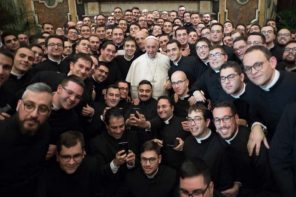Alan Wolfe is a smart writer, always worth reading. His latest piece, in the Atlantic Monthly’s special issue on religion, is especially worth reading, considering the magazine’s influence, his own high standing as a public intellectual, and the very welcome news he brings: Far from being a force for more conflict in the future, religion on a worldwide scale will increasingly be a force for moderating conflict.
Wolfe reaches this conclusion largely by interpreting data released by the Pew Global Attitudes Project last October. It showed that, by and large, the sociologists’ old-fashioned secularization hypothesis is proving true: The more a country industrializes and modernizes, the less influence religion has on people’s lives. As Wolfe notes, this flies in the face of the recent scholarly trend to reject the secularization hypothesis. After all, if you just read the headlines, it seems that religion still has an enormous and growing impact on world events. Yet Wolfe says that the numbers point in just the opposite direction.
This is welcome news to me, not only because I would like to see religion serve as a force for peace, but also because, for years now, I’ve been starting off my intro course on religion and society with Peter Berger’s classic book, The Sacred Canopy. In that book Berger asserts the secularization hypothesis as incontrovertible fact and offers a powerful argument to explain it. Industrial societies need to coordinate the labor of huge numbers of people. They can’t afford to have religious differences played out in the public sphere because that would gum up the works. For the sake of economic efficiency, they have to define religion as a private affair. In your free time, you can be religious (or not) in any way you like, they say in effect. But when you enter the public sphere, you must leave religious identity behind and be a good secular citizen of the state, working together with all others for the well-being of the state.
In recent years, Berger has followed the sociologists’ trend and cast doubt on his own simplistic prediction of growing secularization in the public sphere. Is Wolfe now saying that Berger’s simplistic prediction was actually pretty much on target? It’s hard to know, because Wolfe curiously ignores the public/private distinction that is so central to Berger’s analysis.
Look at the measure of religiosity Wolfe relies on from the Pew data. It’s based on just three questions: Is belief in God necessary for morality? Is religion important in your life? Do you pray at least once a day? In an RDBlog post previewing the Atlantic issue, Gabriel McKee has already cautioned that this is a crude way to measure of religiosity.
But even supposing that it is a generally useful predictor, it measures mainly private religiosity. The second and third questions deal only with the role of religion in the individual’s personal life. And it’s easy enough to interpret the first question, about God and morality, as a question only about personal moral behavior. So it tells us nothing about the role of religion in public institutions and processes. Yet the headlines that have generated such a challenge to the old secularization hypothesis are all about the role of religion in the public sphere.
So a more nuanced reading of Wolfe’s argument might say that religion is losing its power because it is gradually being pushed out of the public sphere into the private sphere. This explains another phenomenon that Wolfe finds central and encouraging: Around the world, we are seeing the growth of the American-style “free religious marketplace.” Religions are gradually becoming commodities that private individuals can accept or reject at their own discretion. The various religions must compete for the consumer loyalty, which means they must adapt to consumer preference. This is the inevitable result of the privatization of religion, as Berger explained in The Sacred Canopy. And when religions must compete in the marketplace, Wolfe argues, they become less strident and more accommodating to a pluralistic tolerance.
So how do we explain the incontrovertible fact that religion is still so deeply implicated in conflict around the world? The most obvious explanation is that, all over the world, there are groups of people who want desperately to resist the modernity that relegates religion to the private sphere. The most powerful way to resist is to force religion into the public sphere. That is bound to elicit countermoves in the public sphere, creating a surefire recipe for public, headline-generating conflict.
Are these conflicts really “about religion”? Here we have to make a crucial distinction that Wolfe, like so many writers, overlooks. Some conflicts are truly motivated by religious concerns. But these “I hate you because you believe or practice differently from me” conflicts are now quite rare. It is much more common to see religious labels affixed to, and often proudly worn by, groups that are motivated by concerns we would generally call secular: gaining or keeping political, economic, and social power.
How should we evaluate the third category, conflicts between modernization and its religiously-rooted opponents? Surely the opponents are fighting to keep religion central in public as well as private life. But once religion is forced into the public sphere, it is bound to get mixed together with the issues that dominate the public sphere—the very political, economic, and social issues that we call secular. So even those who are using force to resist modernity end up, willy-nilly, fighting battles that are not purely religious.
A close look at most of the conflicts that appear to be “about religion” shows that the people resisting modernization are generally not getting what they see as their fair share of its benefits. Some are abjectly poor, getting no benefits at all. More often, they have the background and skills that they think should entitle them to full benefits. Yet the inherently inequitable structures of the global capitalist system deny them what they see as their due.
This is just one well-known piece of a very complicated picture. But it’s a particularly important piece. It suggests that the best way to reduce the so-called “religious” conflicts around the world is not to wait for modernization to do its painfully slow work, but to implement policies that would bring the material benefits of modernization more quickly to everyone, everywhere. Rather than stand by and watch supposedly impersonal processes unfold, as though we were helpless, we can recognize that politics is always about making human choices. We can use the political process to help move the world toward peace.




